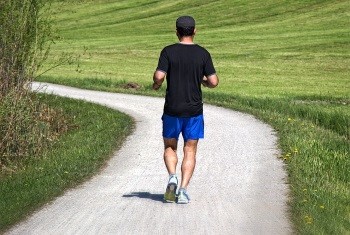Exercising sore muscles
Of course, almost everyone has wondered if they can or should and can play sports despite muscle pain. Even if the answer to this question is not always easy to give, I want to take care of the topic in this article.
This second article in a series on sore muscles focuses on exercising despite sore muscles. I asked you the following questions and I want to answer them in this article:
In the end, you need to know for sure if you have real sore muscles, if you can and what else can be trained or even needed, and when is the right time to start exercising again after sore muscles.
This article is part of a series on sore muscles. I’ve also covered the following topics in this series of articles:
Now back to the topic of training with sore muscles.
How to recognize a real sore muscle
Many people think they have muscle soreness if they don’t have them (or just minor ones). This can be due to various things. For example, some are simply not used to exercise and the associated muscle regeneration responses. Some people just feel different from others.
In fact, there is the exact opposite. Especially people who have been exercising for a little longer sometimes tend to ignore muscle soreness or speak down. According to the motto, there should be a little pain so that the muscles grow, and you train your muscles vividly. In the medium term, of course, this leads to stagnation or even regression and a greater risk of injury during training.
As you can see, the perceived muscle soreness is subjective. Therefore, to make the best decisions you need to make the most objective criteria possible.
Of course, without a medical examination, it is not always possible to say 100% objectively whether you have severe muscle pain or not. However, there are several criteria by which you can easily tell if you have “real” sore muscles, so you should stop exercising.
Basically, there are 4 (relatively) objective factors that you can use to understand that your muscle really hurts and that you are better off taking care of your muscles for a little longer than usual.
The most important signs of sore muscles are:
- Mild muscle pain with minimal movement and no stress
If the pain is severe, it may indicate an even worse injury. In this case, you should see a doctor.
- Significantly limited (painless) range of motion
If your painless range of motion for a joint moved by the affected muscle is markedly limited, you might assume that your sore muscles still require a break.
- Impaired movement even at low loads
If every day small loads can no longer be easily overcome by the muscles, this indicates severe muscle pain. It can also lead to (unconscious) compensatory movements and / or tremors in the muscles.
- Significantly Limited Strength Development Potential
If you already have muscle performance problems with lower than normal training weights, you should still give your muscles a chance to rest.
If one of these positions applies, I would advise you not to go directly to the sore muscles, but to listen to the information in the following sections regarding training with sore muscles and the right time to start again.
I always try to be dependent on these characteristics and how and how I train, or prefer to pause (heavy) training for a few days.
train with sore muscles?
Especially if you, like me, are highly motivated and used to regular training, you will definitely find it difficult to take a long break from your training due to muscle pain. This is especially true if you have a big goal that you would like to accomplish as much as possible.
Trust me, I know this too well. But trust me when I tell you that I never did myself a favor if I meant (hard) training despite my muscle soreness. Planned progress can quickly turn into unwanted setbacks.
I usually say no when it comes to training with sore muscles. Of course, this depends on how strong your sore muscles are. However, if any of the factors in the previous section apply, you should refrain from exercising with sore muscles.
To say across the board that learning is not permitted at all would be too far. In fact, there are very simple types of workouts that can be beneficial even for sore muscles.
So, if you absolutely want to train despite sore muscles, I’ll put together in the next section what options you have without compromising your training success through improper training or even the risk of injury.
How and what you can (and should) train despite muscle soreness
So, you have a muscle sore that is holding you back from a regular workout, but you do not want to go without training, despite the muscle soreness. Next, I want to show you some options for how you can still be active.
Train other muscles
All that is easiest is to train muscles that are not affected by sore muscles. These muscles are still fresh and can be trained without hesitation. If you do split workouts and break your muscles into enough groups, you still need to find a few muscles that you can still train.
However, especially during heavy strength training, make sure that the muscles in which you have muscle soreness should not be subjected to significant tension as accessory muscles. If this is the case with your workout, you will quickly notice it. Then do another exercise, otherwise you will delay regeneration or even risk injury.
Go to the circle
Running is almost always possible. If your leg muscles do not hurt, you can walk even if you move other muscles as well. The intensity of stress there is so low that it should not have any negative consequences. This is especially true if you are not training in the limit zone while running.

Also, regular cardio is very good anyway, recovers quickly from muscle pain and suffers less often. This is due to the improvement of blood circulation and metabolic processes. It is best to do basic endurance training in the low impulse range.
Go for a swim
When I talk about swimming, I mean a relaxed and non-competitive approach. The intensity should be at a level conducive to regeneration. I’m not talking about high performance swimming, but I do a few laps in comfort and maybe go to the sauna afterwards.

Swimming is a great way to do a full body cardio workout and is effective even at low intensity. This makes it extremely effective in initiating and accelerating regeneration processes in the body.
Which always applies if you want to train with sore muscles
Whatever you do, in no case train the muscle affected by the sore muscles, and thus into the sore muscles. That it should make sense is pitch perfect and will not make you progress, but will only bring a lot of setbacks. The risk of injury is also significantly increased.
Another thing also applies: if you cannot perform movements correctly due to pain, then let them be. Find something that you can do painlessly and cleanly across your full range of motion, or just give your body a break. Breaks are essential for your training success; this applies to breaks between sets and workouts. A full workout break can make sense for your body from time to time.
when you can start training again after muscle pain
Now, perhaps you have paused for a few days, you could not train with sore muscles, and it already got weaker. Of course, your fingers itch to finally start exercising again. But you don’t want to start again too early. Basically, it’s like exercising again after the flu. Coming back too early is the worst thing you can do.
Should I wait until the sore muscles have completely disappeared? After all, you don’t want to wait too long, but rather get the best time to start your workout again. According to research, this is actually achieved somewhat earlier.
Recognizing the right time to return is not easy. This is also due to the fact that mainly subjective factors are used for the assessment. However, as a rule, the rule is: better a little later than a little earlier.
Based on identifying features of severe muscle soreness, there are, however, some (reasonably) objective factors that you can use to determine if your muscles have recovered enough from sore muscles and are ready for a new workout.
To determine if you should exercise again after muscle pain, I recommend checking the following:
1. Remaining Pain Strength Assessment
On a scale of 1 to 10, muscle pain when moving lightly should not exceed 2-3. So you can still feel the muscles, but the movement should no longer be painful.
2. Checking the possible range of motion
The possible range of motion should no longer be noticeably limited. You should be able to perform all movements during your workout without feeling pain from a specific range of motion.
3. Check for clean execution
A clean execution of the exercise without evasive movements should also be possible under load (and without pain). This applies (in particular) to difficult basic exercises, as well as isolation exercises, as well as sequence of movements, for example, when running. You must acknowledge possible deviations from pain avoidance. Pay close attention and don’t be fooled. Clean execution is one of the most important building blocks of effective learning.
4. Test of possible power development
If you can get that far, go back to training with your normal training weight, do regular exercise and see how well you do the exercise. Despite mild muscle pain, can you develop the same strength as before? If you were happy with the weight and repetitions on a typical training day, you are fine. If you feel pain or a strong burning sensation in the muscles in the middle of a sentence, interrupt the sentence and give the muscles a little rest.
Have you completed all tests?
If all of these tests are positive, you can re-incorporate the relevant muscles into your workouts. Under no circumstances should you overdo it again because you don’t want to immediately experience muscle pain.
By the way, I always recommend that beginners take a break until the muscle pain has completely subsided. However, if you already have 1 or 2 years of learning experience or more, you should feel very good about following the rules above.
Your conclusion to training with sore muscles
No one likes to hurt muscles that prevent them from exercising. It doesn’t matter if you want to continue or run faster, build muscle, or define your muscles. No one likes to take forced breaks from their workouts. However, if you realize that you have really severe muscle pain, then in any case, you should give your muscles the necessary break. Even if you are the biggest bastard bastard, you have to use discretion if you want to achieve your goals in a healthy and safe way.
You don’t have to just wait and do nothing until your aching muscles have healed. There are several things you can do to sore muscles to help them heal faster. A little regeneration workout, healthy sleep and relaxation, and a healthy diet with enough fruits and vegetables and a few smart nutritional supplements will help you get back faster. You’ve reached your full potential.
In general, you should never deprive your muscles of the ability to regenerate. Under no circumstances should you start hard training of the affected muscles too early. If you do this, you run the risk of overtraining or even injury. However, if you adhere to the rules of returning to work, this should no longer be a problem for you in the future.
BTW: If you want to build muscle as efficiently as possible, with controlled effort and (almost) no muscle soreness, check out my Muscle Building Basics. The workout is designed in such a way that after a little getting used to it, you should not have sore muscles, and you can still achieve very good results (or because of this).
Sports greetings

And don’t forget: your health is your health.
